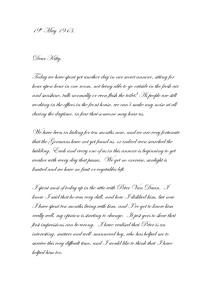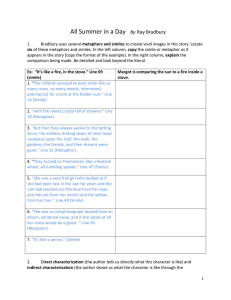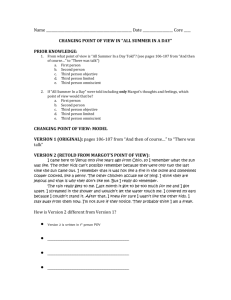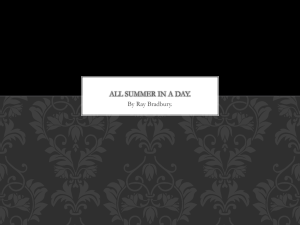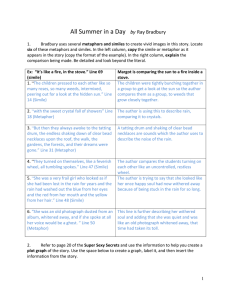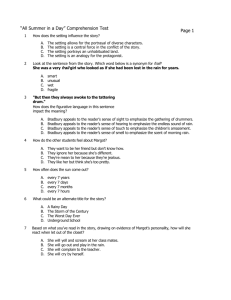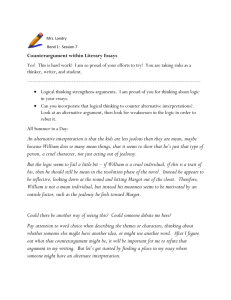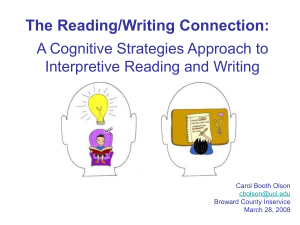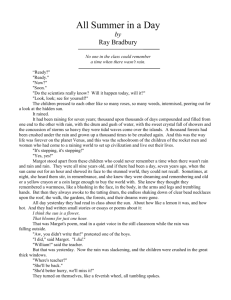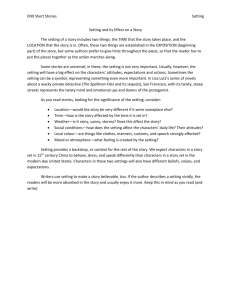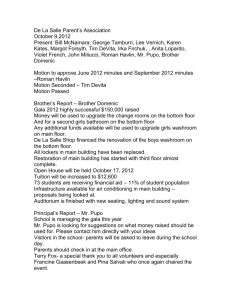“All Summer in a Day” by Ray Bradbury Close Reading Questions
advertisement
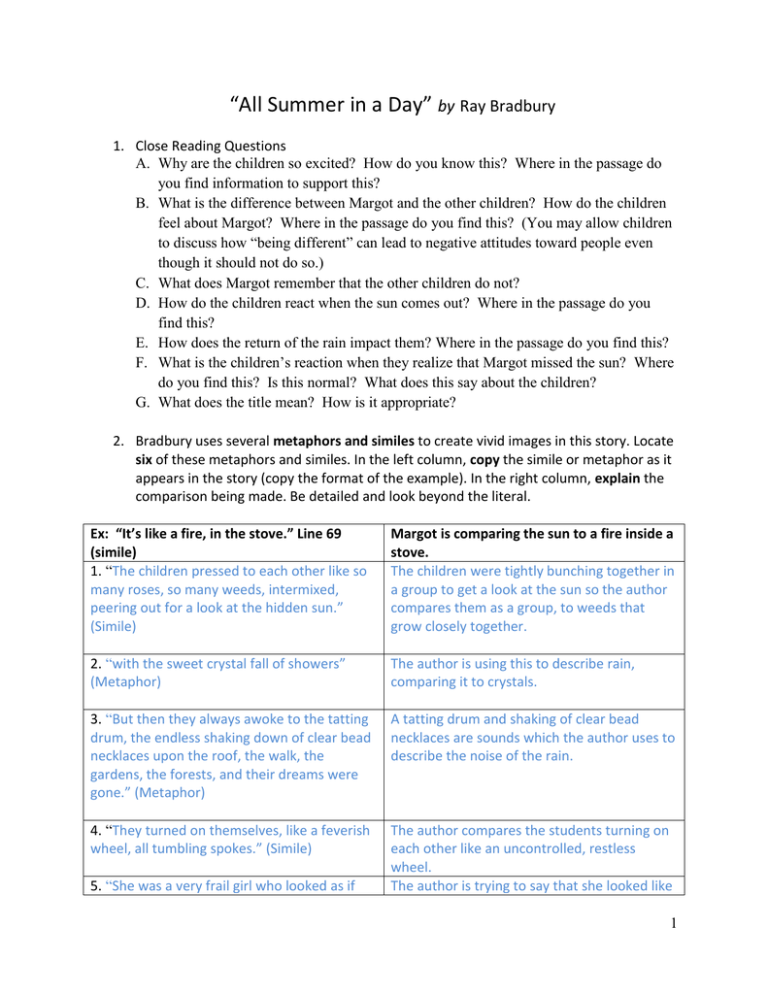
“All Summer in a Day” by Ray Bradbury 1. Close Reading Questions A. Why are the children so excited? How do you know this? Where in the passage do you find information to support this? B. What is the difference between Margot and the other children? How do the children feel about Margot? Where in the passage do you find this? (You may allow children to discuss how “being different” can lead to negative attitudes toward people even though it should not do so.) C. What does Margot remember that the other children do not? D. How do the children react when the sun comes out? Where in the passage do you find this? E. How does the return of the rain impact them? Where in the passage do you find this? F. What is the children’s reaction when they realize that Margot missed the sun? Where do you find this? Is this normal? What does this say about the children? G. What does the title mean? How is it appropriate? 2. Bradbury uses several metaphors and similes to create vivid images in this story. Locate six of these metaphors and similes. In the left column, copy the simile or metaphor as it appears in the story (copy the format of the example). In the right column, explain the comparison being made. Be detailed and look beyond the literal. Ex: “It’s like a fire, in the stove.” Line 69 (simile) 1. “The children pressed to each other like so many roses, so many weeds, intermixed, peering out for a look at the hidden sun.” (Simile) Margot is comparing the sun to a fire inside a stove. The children were tightly bunching together in a group to get a look at the sun so the author compares them as a group, to weeds that grow closely together. 2. “with the sweet crystal fall of showers” (Metaphor) The author is using this to describe rain, comparing it to crystals. 3. “But then they always awoke to the tatting drum, the endless shaking down of clear bead necklaces upon the roof, the walk, the gardens, the forests, and their dreams were gone.” (Metaphor) A tatting drum and shaking of clear bead necklaces are sounds which the author uses to describe the noise of the rain. 4. “They turned on themselves, like a feverish wheel, all tumbling spokes.” (Simile) The author compares the students turning on each other like an uncontrolled, restless wheel. The author is trying to say that she looked like 5. “She was a very frail girl who looked as if 1 she had been lost in the rain for years and the rain had washed out the blue from her eyes and the red from her mouth and the yellow from her hair.” (Simile) her once happy soul had now withered away because of being stuck in the rain for so long. 6. “She was an old photograph dusted from an album, whitened away, and if she spoke at all her voice would be a ghost. “ (Metaphor) This line is further describing her withered soul and adding that she was quiet and was like an old photograph whitened away, that time had taken its toll. She is describing the sun to the kids. She is trying to describe the color. 7. “It’s like a penny.” (Simile) 3. Direct characterization (the author tells us directly what this character is like) and indirect characterization (the author shows us what the character is like through the character’s actions, thoughts, and words) are both used in the story. Find an example of each for the character Margot. Direct characterization: She was a very frail girl who looked as if she had been lost in the rain for years and the rain had washed out the blue from her eyes and the red from her mouth and the yellow from her hair. She was an old photograph dusted from an album, whitened away, and if she spoke at all her voice would be a ghost. Indirect Characterization: But she did not move; rather she let herself be moved only by him and nothing else. But she remembered and stood quietly apart from all of them and watched the patterning windows. And once, a month ago, she had refused to shower in the school shower rooms, had clutched her hands to her ears and over her head, screaming the water mustn't touch her head. 4. Figure out as many types of conflict as you can in the story. Fill out the chart below. Type of Conflict Person vs. Person Person vs. Group Example from Story (with line number/s) "What're you looking at?" said William. Margot said nothing. "Speak when you're spoken to." He gave her a shove. (Lines 53-55) They surged about her, caught her up and bore her, protesting, and then pleading, and then crying, back into a tunnel, a room, a closet, where they slammed and locked the 2 Person vs. Nature door. They stood looking at the door and saw it tremble from her beating and throwing herself against it. They heard her muffled cries. (Lines 93-95) And then, of course, the biggest crime of all was that she had come here only five years ago from Earth, and she remembered the sun and the way the sun was and the sky was when she was four in Ohio. (Lines 62-63) 5. What causes the main conflict in the story? What is the main conflict? The kids are jealous of Margot’s knowledge of the sun. Person vs. Group / Margot vs. Other students 6. “All Summer in a Day” is an example of dystopian literature. A dystopia is the idea of a society in a repressive and controlled state, often under the guise of being utopian. Ideas and works about dystopian societies often explore the concept of humans abusing technology and humans individually and collectively coping, or not being able to properly cope with technology that has progressed far more rapidly than humanity's spiritual evolution There are many common traits that dystopic societies contain: a. Society: most impose severe social restrictions on community members - social stratification: social class is strictly defined and enforced - ruthless egalitarian - repression of the intellectual b. Social Groups: total absence of social groups other than the “state” - independent religion is notable because of omittance - family is attacked: the hostility to motherhood c. Nature: characters are isolated from the natural world -conditioned to fear nature d. Political: Government asserts power over citizens - flawed in some way—portrayed as oppressive - filled with pessimistic views of the ruling class—rules with an “iron fist” e. Economic: state is in control of the economy - black market—items banned or seen as contraband - often privatization in businesses f. The Hero: protagonist questions society—intuition - is a rebel, or an outsider g. Conflict: societal group somewhere not under control of state 3 -the protagonist puts his/her faith in these people, but futilely h. Climax: can be unresolved - death or re-education/conformity -usually the opposite of a “happy ending” What characteristics of dystopian society are present in this story? Nature: Margot once experienced sun for most of the year when she lived on earth, but now that she lived on Venus, she had not experienced sun for at least 5 years. The Hero: Margot is an outsider because she is the only kid in her class the remembers what the sun looks like, so the other students think she’s somewhat out of her mind, thus leaving her separate from the group. Climax: Margot misses out on the 1 day of sun for the next 7 years, therefore she will not be able to see it again until she is 16, or move back to earth. 7. What kind of world does Margot live in? How does it compare to our world? It rains every single day. There is only 2 hours of sun on one day every 7 years. In all honesty, it sounds dreadful. 8. In “All Summer in a Day,” Margot is like a captive. She is trapped, living under conditions that are slowly destroying her. What are some conditions here on Earth that are similar to Margot’s? List at least three. Poverty Third world countries Countries with lots of wars 9. A theme in this story has something to do with why people are sometimes cruel to one another. The author says the children hated Margot for: “all these reasons of big and little consequence. They hated her pale snow face, her waiting silence, her thinness and her possible future….” (lines 77-78) Tell which of these reasons you think are of “big consequence” and which are of “little consequence.” She was different. She remembered the sun. 4 She didn’t seem to like being around them. She was from earth and had only come to Venus when she was 4. Based on this information, what is the theme of the story? (Answers will vary. As long as students can defend their answers with evidence, they should be given credit.) 5
